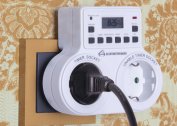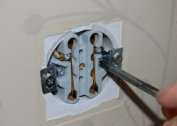Motion sensor - an electronic device that responds to the appearance and movement of objects in the field of action by shorting the power circuit. Depending on the viewing angle and other operating parameters of the device, it can be successfully used to protect objects, ensure safe passage in the dark and for other purposes related to household and professional activities of a person. The use of sensors in everyday life and at commercial facilities is dictated by safety considerations, as well as the need to save electricity and other resources in places where their constant consumption is not necessary.
Motion sensor circuit for lighting
Under the back cover of the device, there is a terminal block with three colored wires that extend outside the case. Wires are connected to terminal clamps or to insulated lugs, if connected using a multi-core cable. The sensor is connected to the network, the power passes through the brown wire of phase L and through the blue wire of zero phase. At the exit from the housing, both phases go to the incandescent lamp of the lighting device or to other devices, the inclusion of which is necessary when there are signs of movement in the coverage area. If movement is noted in the sensitivity area, the device is triggered, the relay contact closes with the current supply to the lamp, and it turns on.
You can get comprehensive information about the design of the purchased motion sensor from the manufacturer's instructions attached to the device. In addition, a schematic representation of the optimal connection method is indicated on the cover of the model.
The principle of operation is simple. When a moving object appears in the coverage area, the electric network instantly closes, including devices and equipment connected to the sensor: lighting, air conditioning and ventilation systems, etc. In the absence of signs of movement for a certain period of time, the electric circuit opens, all devices turn off. Thus, it is possible to avoid the continuous operation of energy-intensive devices and to economically consume their working resource.
Connecting light sensors
 Installation work is carried out in the following sequence:
Installation work is carried out in the following sequence:
- We study the circuit diagram of the phase wire connection, attached to the device instructions.
- The housing cover is removed.
- The device is connected to the power supply using wires that are fixed to the screw terminals of the terminal block.
- The cables in the junction box are connected. There are seven wires in it - supplying zero and phase, three sensor cables and two lamp cables. In the power cable, zero is indicated in blue, phase is brown. The cable connected to the sensor, the insulation of the phase wire is colored white, zero - in green. The remaining red cable connects to the load. Separately, phase wires are connected, separately - zero wires of the network, sensor and lamp. Then connect the red sensor cable and the brown phase cable of the lamp.
An error in the connection of wires can lead to serious damage and burning of the device. If you can’t connect the devices yourself, you should use the qualified help of specialists. They will carry out installation work in full and configure all the equipment taking into account the features of its operation and your wishes.
Connection diagram DD with a switch for street lighting
If it is necessary to turn on the power in the tracking zone outside the moment of its operation, an additional switch is connected to the network. Its presence does not affect the operation of the monitoring device, since in this case a parallel connection scheme is used. The sensor still does its job of detecting moving objects and switching devices connected to the network. In turn, the switch allows you to:
- operate lights, ventilation and other devices regardless of the sensor;
- extend their time after the circuit in the relay opens;
- duplicate the operation of the sensor, controlling the lighting in forced mode.
The installation of a switch at the exit from the house into an unlit zone can be called expedient. Such a solution will not require large expenditures, but it will increase the level of security when moving around the territory near the house at unlit time of day.
Installation site recommendations
Proper installation of the motion sensor to turn on the light involves taking into account the following points:
- The best arrangement is the area of contact between the illuminated and dark areas of the object. It is important that the device responds to movement immediately at the border of the unlit zone, immediately turning on the lamp when a moving person moves to the dark part of the territory.
- Thanks to the adjustable base, you can focus the device at the desired point in the surveillance zone - for example, at the gate of a private house gate or at the entrance to the territory of a commercial facility. Infrared radiation is directed to the side where the appearance of moving objects is most likely and operational response is guaranteed.
In a small area, it is better to install the sensor in the upper part of the wall, in a private house - on the highest part of the building. This installation method will cover a large area
Setup after connection
 Flexible sensor settings allow you to take into account the features of the object and achieve a prompt response of the device when there are signs of movement. The vast majority of modern models offer the owner to choose three main parameters at his discretion - the “TIME” shut-off delay, the ambient light threshold “LUX” and the degree of sensitivity to infrared radiation “SENS”.
Flexible sensor settings allow you to take into account the features of the object and achieve a prompt response of the device when there are signs of movement. The vast majority of modern models offer the owner to choose three main parameters at his discretion - the “TIME” shut-off delay, the ambient light threshold “LUX” and the degree of sensitivity to infrared radiation “SENS”.
- “TIME” time settings are offered in the range from 1 to 600 seconds. They can be added to threshold values - from 5 seconds to 8 minutes. During the selected time, the electric circuit will be closed, and the connected devices will be in working condition. Of particular importance here is the location of the sensor and its purpose. If we are talking about the territory near a private home, the operating time of the sensor and the searchlight connected to it at night should be calculated taking into account the speed of a person moving from the gate to the threshold of the house. As a rule, this is about 15-30 seconds. For sensors located in work or auxiliary rooms, it is better to increase the duration of lighting by a few minutes.
- The “LUX” setting allows you to adjust the sensor in full daylight conditions. The higher the selected value, the better the device will respond to movement in daylight - for example, on a sunny day on the street or with a large number of windows in the room. Otherwise, if the illumination quality of the object is higher than the set parameter, the sensor may not work.
- The SENS controller allows you to adjust the sensitivity of the device so that it clearly responds to the appearance of a person or car in the control zone, but does not work when moving pets. This parameter is also responsible for the reaction of the sensor to movement at the farthest boundary of the control zone.The higher its value, the more guarantees that the device will work by detecting movement at a considerable distance within the guarded object. In the winter season, in conditions of weaker illumination, the sensitivity should be increased, and with the onset of summer, it should be reduced, thereby eliminating false alarms. In some cases, you can increase the sensitivity of the sensor by changing the angle of its direction.
All sensor settings are set and tested in experimental mode until optimal results are achieved. A high response frequency or low sensitivity can be corrected by changing the corresponding setting up or down. If necessary, specialists of the seller company can be connected to the installation work and additional settings. They can also get advice on all aspects of the operation and maintenance of the sensor.





